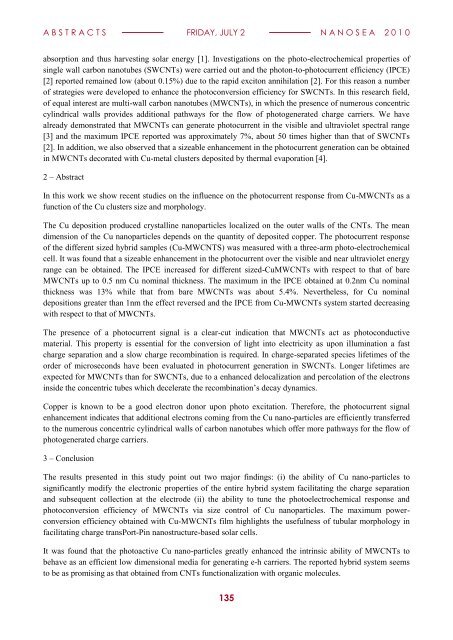book of abstracts - IM2NP
book of abstracts - IM2NP
book of abstracts - IM2NP
You also want an ePaper? Increase the reach of your titles
YUMPU automatically turns print PDFs into web optimized ePapers that Google loves.
A B S T R A C T S FRIDAY, JULY 2 N A N O S E A 2 0 1 0<br />
absorption and thus harvesting solar energy [1]. Investigations on the photo-electrochemical properties <strong>of</strong><br />
single wall carbon nanotubes (SWCNTs) were carried out and the photon-to-photocurrent efficiency (IPCE)<br />
[2] reported remained low (about 0.15%) due to the rapid exciton annihilation [2]. For this reason a number<br />
<strong>of</strong> strategies were developed to enhance the photoconversion efficiency for SWCNTs. In this research field,<br />
<strong>of</strong> equal interest are multi-wall carbon nanotubes (MWCNTs), in which the presence <strong>of</strong> numerous concentric<br />
cylindrical walls provides additional pathways for the flow <strong>of</strong> photogenerated charge carriers. We have<br />
already demonstrated that MWCNTs can generate photocurrent in the visible and ultraviolet spectral range<br />
[3] and the maximum IPCE reported was approximately 7%, about 50 times higher than that <strong>of</strong> SWCNTs<br />
[2]. In addition, we also observed that a sizeable enhancement in the photocurrent generation can be obtained<br />
in MWCNTs decorated with Cu-metal clusters deposited by thermal evaporation [4].<br />
2 – Abstract<br />
In this work we show recent studies on the influence on the photocurrent response from Cu-MWCNTs as a<br />
function <strong>of</strong> the Cu clusters size and morphology.<br />
The Cu deposition produced crystalline nanoparticles localized on the outer walls <strong>of</strong> the CNTs. The mean<br />
dimension <strong>of</strong> the Cu nanoparticles depends on the quantity <strong>of</strong> deposited copper. The photocurrent response<br />
<strong>of</strong> the different sized hybrid samples (Cu-MWCNTS) was measured with a three-arm photo-electrochemical<br />
cell. It was found that a sizeable enhancement in the photocurrent over the visible and near ultraviolet energy<br />
range can be obtained. The IPCE increased for different sized-CuMWCNTs with respect to that <strong>of</strong> bare<br />
MWCNTs up to 0.5 nm Cu nominal thickness. The maximum in the IPCE obtained at 0.2nm Cu nominal<br />
thickness was 13% while that from bare MWCNTs was about 5.4%. Nevertheless, for Cu nominal<br />
depositions greater than 1nm the effect reversed and the IPCE from Cu-MWCNTs system started decreasing<br />
with respect to that <strong>of</strong> MWCNTs.<br />
The presence <strong>of</strong> a photocurrent signal is a clear-cut indication that MWCNTs act as photoconductive<br />
material. This property is essential for the conversion <strong>of</strong> light into electricity as upon illumination a fast<br />
charge separation and a slow charge recombination is required. In charge-separated species lifetimes <strong>of</strong> the<br />
order <strong>of</strong> microseconds have been evaluated in photocurrent generation in SWCNTs. Longer lifetimes are<br />
expected for MWCNTs than for SWCNTs, due to a enhanced delocalization and percolation <strong>of</strong> the electrons<br />
inside the concentric tubes which decelerate the recombination‟s decay dynamics.<br />
Copper is known to be a good electron donor upon photo excitation. Therefore, the photocurrent signal<br />
enhancement indicates that additional electrons coming from the Cu nano-particles are efficiently transferred<br />
to the numerous concentric cylindrical walls <strong>of</strong> carbon nanotubes which <strong>of</strong>fer more pathways for the flow <strong>of</strong><br />
photogenerated charge carriers.<br />
3 – Conclusion<br />
The results presented in this study point out two major findings: (i) the ability <strong>of</strong> Cu nano-particles to<br />
significantly modify the electronic properties <strong>of</strong> the entire hybrid system facilitating the charge separation<br />
and subsequent collection at the electrode (ii) the ability to tune the photoelectrochemical response and<br />
photoconversion efficiency <strong>of</strong> MWCNTs via size control <strong>of</strong> Cu nanoparticles. The maximum powerconversion<br />
efficiency obtained with Cu-MWCNTs film highlights the usefulness <strong>of</strong> tubular morphology in<br />
facilitating charge transPort-Pin nanostructure-based solar cells.<br />
It was found that the photoactive Cu nano-particles greatly enhanced the intrinsic ability <strong>of</strong> MWCNTs to<br />
behave as an efficient low dimensional media for generating e-h carriers. The reported hybrid system seems<br />
to be as promising as that obtained from CNTs functionalization with organic molecules.<br />
135

















